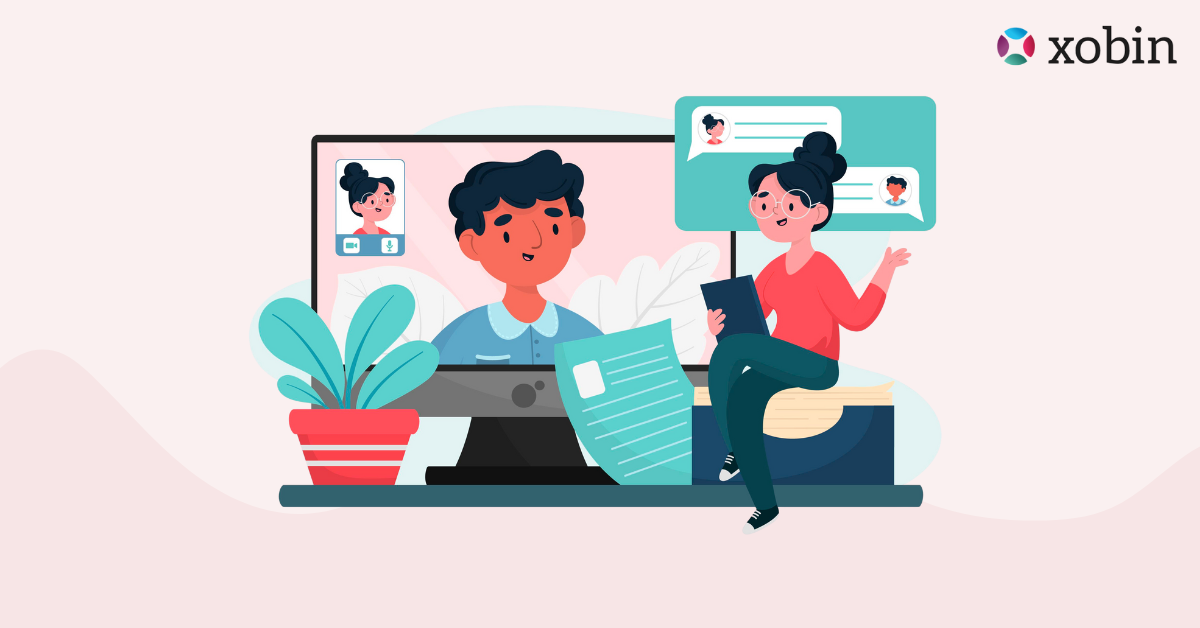Video interviews now play a key role in modern hiring. As businesses shift to remote and hybrid work, this AI-powered method reshapes recruitment. Today, more than 87% of companies from large enterprises to fast-moving startups are actively using video interviews as a core part of their hiring process.
Table of Contents
So, what is a video interview? How does it work, and why are forward-thinking organizations relying on it more than ever? This guide offers a complete understanding of how video interviews work, their different formats, benefits, challenges, and actionable best practices that are reshaping modern recruitment.
TL;DR – Key Takeaways!
- Video interviews are online, flexible hiring tools that are conducted live or pre-recorded to screen candidates efficiently across locations.
- There are various types of video interviews including live, one-way (asynchronous), on-demand, automated, AI-based, and panel formats.
- Companies use them to speed up hiring, reach global talent, reduce costs, and make data-driven, bias-free decisions.
- AI video interview tools analyze tone, behavior, and soft skills, helping recruiters evaluate candidates objectively.
- Platforms like Xobin enable structured workflows, customizable assessments, and GDPR-compliant, secure video screenings.
- Video interviews expand access to global talent and improve the candidate experience.
- Ideal for startups, enterprises, and remote-first teams conducting remote, high-volume, and campus hiring with measurable ROI.
What is a Video Interview, and How Does It Work?
A video interview lets employers interview candidates online using a webcam or smartphone. It takes place over the internet and can be either live (real-time) or recorded in advance (asynchronous), based on the type and purpose.
In simple terms, a video interview means using technology to replace or complement face-to-face interviews, offering flexibility, scalability, and improved efficiency.
So, how do video interviews work in a typical hiring scenario?
It’s simple! Here’s how:
- Invitation: HR teams invite selected candidates to join a video interview platform.
- Question Setup: Employers pre-load or prepare video interview questions for HR to assess technical, behavioral, or cultural fit.
- Recording or Live Interaction: Candidates either answer in recorded video interviews (on their own time) or engage in a live video interview with recruiters.
- Review and Analysis: Recruiters may be present in real-time or review the recording later. They can replay, evaluate, and rate answers using the best AI video interview software, like Xobin, that also provides sentiment analysis, facial cues, and soft-skill scoring.
- Shortlisting: Candidates are shortlisted based on evaluation metrics and proceed to the next steps in the hiring funnel.
In a world driven by remote work, AI-driven video interview software for hiring like Xobin provides structured workflows, question templates, AI-assisted evaluations, and secure cloud-based recordings to streamline the video interview process.
Key Features of Modern Video Interviews:
- High-quality HD video and audio
- Automated scheduling and reminders
- Built-in AI-based video interview for unbiased analysis
- Support for both asynchronous video interviews and live formats
- Collaboration tools for hiring panel
- Centralized dashboard for reviewing and scoring interviews
Different Types of Video Interviews Used in Hiring
Understanding the types of video interviews helps employers choose the right format for specific roles. Depending on the position, stage in the recruitment funnel, and urgency, companies opt for one or a combination of the following:
Live Video Interview
A real-time virtual meeting where the recruiter and candidate interact via webcam. This mimics the traditional face-to-face interview but removes geographic barriers.
Best For: Final-round interviews, leadership roles, or high-context positions.
One-Way Video Interview (Asynchronous)
Candidates record their responses to preset questions in a recorded video interview. They can answer whenever it suits them, while recruiters review responses easily at scale. Reviewers can watch the recording at any time.
Best For: Early-stage screening, volume hiring, remote candidates.
Automated Video Interview
An AI-based video interview automatically screens responses, analyzes behavior, and shortlists candidates. The best video interview tools, like Xobin, bring advanced scoring and psychometric analysis into this format.
Best For: Reducing bias and increasing hiring objectivity.
On-Demand Video Interview
A type of video screening where candidates can start interviews anytime based on employer-defined windows.
Best For: High-volume roles, campus recruitment, and time-zone flexibility.
AI-Based Video Interview
An AI video interview uses machine learning to study facial expressions, tone, and soft skills. Xobin applies ethical AI to provide insights backed by data.
Panel or Group Video Interviews
A group of interviewers from different locations join the call. Ideal for cross-functional or senior-level hiring.
Best For: Strategic or C-level hires, collaborative hiring decisions.
How Do Companies Use Video Interviews for Recruitment?
In 2025, the way companies approach hiring is significantly different from even a few years ago. To keep up with evolving candidate expectations and a highly competitive talent market, organizations are integrating video interviews into their core recruitment strategy. But it’s not just about replacing face-to-face interactions; it’s about rethinking how interviews can be more efficient, consistent, and scalable.
Let’s explore the top reasons why companies are embracing video interviewing as part of a modern hiring workflow.
Faster Screening at Scale
Traditional screening methods often delay the hiring cycle, especially when dealing with high application volumes. A video screening process, particularly through asynchronous video interviews, allows recruiters to review multiple candidates on their schedule. This approach significantly reduces the time-to-hire without compromising on candidate quality.
Consistent and Fair Evaluations
Biased or flawed hiring decisions often result from inconsistent interviews. With recorded video interviews, every candidate receives the same set of questions, making evaluations more objective. Many companies use AI-based video interview platforms like Xobin to ensure structured scoring and data-backed assessments.
Improved Collaboration Among Hiring Teams
Video interview software for recruitment enables different stakeholders, recruiters, hiring managers, and department heads to access and review interview recordings anytime. This allows for better collaboration and more informed decision-making, especially when hiring across departments or locations.
Reaching a Wider Talent Pool
Remote work has broadened the talent landscape. Organizations no longer need to limit hiring to local applicants. With an online video interview, they can engage with candidates from anywhere in the world, increasing access to top talent while reducing travel costs.
Enhanced Candidate Experience
Job seekers today look for flexibility and transparency. AI video interview software, when designed well, gives clear instructions, retry options, and easy-to-use interfaces. This reduces candidate stress, improves their experience, and strengthens employer branding.
Data-Driven Hiring Decisions
Modern platforms do more than just record videos. They use AI to study tone, facial expressions, and how clearly someone speaks. As a result, recruiters get useful insights to make smart, data-driven decisions. For instance, Xobin’s automated video interview tool evaluates not only what a candidate says but also how they say it.
Effective Remote and Campus Hiring
Companies hiring across multiple campuses or remote regions use on-demand video interview solutions to screen candidates uniformly. This ensures standardization, saves logistical costs, and speeds up initial screening phases.
Real-World Examples of Successful Video Interviews
Many global enterprises and unicorn startups now use AI-based video interview tools to speed up hiring. Let’s explore a few success stories:
- A Fortune 500 IT services company reduced screening time by 68% using Xobin’s automated video interview platform for lateral hiring.
- A global FMCG brand used recorded video interviews in campus drives, increasing the offer-to-join ratio by 32%.
- A tech unicorn leveraged video screening for early-stage developer roles using Xobin’s AI engine, filtering 500+ applicants in 48 hours.
These examples of successful video interviews highlight how organizations optimize outcomes without compromising on quality.
Best Practices for Conducting Remote Video Interviews
To ensure a smooth and effective video interview, it’s essential to follow best practices that balance technology with a positive candidate experience.
Prepare Clear and Role-Specific Questions
Design structured, relevant questions aligned with the job role. This helps maintain consistency and fairness across candidates.
Test Technology in Advance
Check that the video platform, camera, mic, and internet connection all work properly. Choose trusted video interview platforms to prevent any disruptions.
Create a Comfortable Candidate Experience
Offer clear instructions, allow practice sessions, and keep the interface user-friendly. A seamless setup reflects well on your employer brand.
Use Structured Evaluation Criteria
Predefine scorecards to assess responses objectively. This helps eliminate bias and simplifies decision-making.
Record and Review When Needed
Leverage features like recorded video interviews for better collaboration and review. It enables multiple stakeholders to evaluate asynchronously.
Why Are Video Interviews Popular in Modern Recruitment?
The shift towards digital-first hiring isn’t just a reaction to remote work; it’s a reflection of evolving candidate expectations, efficiency goals, and global competition for talent. Today, video interviews are a key component of modern recruitment strategies. But what makes them so effective?
Let’s explore the most compelling benefits of video interviews that make them a top choice.
Faster Time-to-Hire
Speed drives today’s hiring process. Traditional interviews require juggling schedules, planning travel, and waiting for availability. Video interviews remove these delays.
With asynchronous video interviews, candidates can respond at their convenience, and recruiters can evaluate submissions anytime, leading to quicker decision-making and faster offer rollouts.
Enhanced Hiring Efficiency
Using a structured video interviewing process, companies can screen hundreds of candidates in a fraction of the time. Features like automated scheduling, AI-based evaluations, and replayable responses help recruiters stay organized and focused.
Xobin’s automated video interviews provide instant insights based on voice tone, speech patterns, and facial cues, reducing manual work while improving quality.
Access to Global Talent
In today’s hybrid or remote-first world, companies hire without being limited to their zip code. A video interview for hiring allows easy interaction with candidates in different cities, countries, or even continents, without paying for costly travel.
As a result, it gives access to a wider and more diverse talent pool.
Better Candidate Experience
Modern candidates value convenience. With features like one-click access, retry options, and clear instructions, a well-designed online video interview feels intuitive and stress-free.
Unlike phone screens, candidates also get a chance to make a more personal impression, putting their communication skills, confidence, and personality on display.
Consistent and Fair Evaluation
Hiring bias remains a serious concern. One-way video interviews ask every applicant the same set of questions in identical conditions. With AI video interview tools, companies can reduce unconscious bias and evaluate applicants based on skills instead of gut instinct.
As a result, hiring becomes fairer and more inclusive.
Scalability for High-Volume Hiring
Hiring for multiple roles or running large-scale recruitment drives can be overwhelming. The best video interview platforms provide a scalable way to manage applications at scale.
For example, in campus recruitment or seasonal hiring, recruiters can assess hundreds of candidates simultaneously without scheduling conflicts or lengthy back-and-forths.
Detailed Candidate Insights
Going beyond surface-level impressions, AI-based video interview tools analyze various soft skills, from emotional intelligence to communication style. These insights, often challenging to capture on phone screens, help hiring teams make more informed decisions.
Moreover, platforms like Xobin allow teams to share candidate recordings internally, enabling collaborative decision-making without needing to repeat interviews.
Cost Savings Across the Board
Travel, logistics, and time investments in traditional interviews can be costly. With video interview platforms, companies reduce administrative overheads, minimize time spent per candidate, and optimize recruiter bandwidth, all while maintaining a high-quality selection process.
Challenges of Video Interviews for Recruiters + Effective Solutions
While video interviews streamline hiring, recruiters may face specific challenges. Understanding these obstacles and applying innovative solutions can enhance the experience for both recruiters and candidates.
Technical Difficulties
Not all candidates have access to high-speed internet or updated devices. Issues like poor video quality, audio lag, or platform crashes can interrupt the flow and leave a negative impression on both sides.
Solution: Use reliable, browser-based video interview platforms that don’t require downloads and offer fallback features. Tools like Xobin provide retry options and real-time technical support to prevent dropouts and ensure a seamless experience.
Candidate Discomfort with Camera-Based Interaction
Many candidates feel nervous or uncomfortable talking to a screen, especially during one-way video interviews. This often causes them to underperform and struggle to show their real potential.
Solution: Provide a short demo or trial before the real video interview. Xobin helps candidates explore the interface, reduce stress, and give more genuine answers.
Loss of Human Connection
Recruiters often find it harder to build rapport during online video interviews, especially when body language and emotional cues are less apparent.
Solution: Combine live interaction with asynchronous video interviews. This two-step method boosts efficiency while keeping the human touch, offering the perks of automation without sacrificing personalization.
Bias in AI-Powered Evaluation
As more companies adopt AI-based video interview tools, concerns around algorithmic bias have grown. If not monitored, AI may unfairly favor or penalize candidates based on non-job-related traits.
Solution: Select platforms that offer explainable AI with regular audits and customizable evaluation criteria. Xobin’s AI engine, for example, includes fairness safeguards and allows recruiters to adjust scoring based on role requirements.
Lack of Standardized Evaluation
Without a clear framework, recruiters may interpret candidate responses inconsistently, especially in recorded video interviews. This can affect hiring decisions and create legal or compliance risks.
Solution: Use structured rubrics and predefined scorecards to assess each response against the same parameters. Xobin provides built-in templates aligned with job competencies to maintain consistency.
Data Security and Compliance Risks
Storing large volumes of recorded interviews raises questions around data protection, especially under regulations like GDPR and CCPA.
Solution: Ensure that your video interviewing software follows global compliance standards, offers encrypted storage, and obtains clear candidate consent. Leading tools like Xobin are fully compliant, helping you stay secure and legally protected.
Future-Proof Your Hiring with Xobin’s Video Interviews!
As hiring becomes more competitive, data-driven, and candidate-focused, the traditional methods can’t keep up. The video interview has proven to be more than a temporary solution; it’s now a strategic advantage that helps businesses move faster, hire smarter, and deliver a superior candidate experience.
If you’re looking to reduce time-to-hire, improve screening accuracy, and build a scalable recruitment process without compromising on quality, it’s time to upgrade.
Xobin offers an all-in-one AI-powered video interview platform designed to help forward-thinking companies like yours hire with confidence. From asynchronous video interviews to automated evaluation, Xobin equips your team with everything you need to make better hiring decisions at scale.
- AI-backed candidate scoring
- Customizable video workflows
- Behavioral and soft-skill analysis
- Secure, GDPR-compliant infrastructure
- Seamless integration with your ATS
Over 5000 companies trust Xobin to power their recruitment process. Simplify your hiring process with ease. Schedule a personalized demo today to experience the future of talent acquisition.
FAQs
What is a video interview in recruitment?
A video interview is a digital hiring method where candidates respond to interview questions via webcam or mobile device, either live or pre-recorded, allowing recruiters to assess them remotely and efficiently.
Are AI-based video interviews ethical?
Yes, when designed transparently and used responsibly, AI-based video interviews are ethical. They reduce human bias and ensure fairer evaluations, especially when backed by explainable AI and compliant with data privacy laws.
How can I prepare candidates for a video interview?
Share clear instructions, recommend a quiet space with good lighting, and provide a practice session. Using candidate-friendly platforms like Xobin helps ease nerves and improve performance.
Can small companies use video interview tools?
Absolutely. Video interview tools are scalable and cost-effective, making them ideal for startups and SMEs looking to streamline hiring without compromising on candidate quality.
Can video interviews help reduce bias in recruitment?
Yes. Structured questions, standardized evaluation, and AI scoring in video interviews minimize unconscious bias and promote fairer hiring decisions.
Do video interviews improve candidate experience?
Definitely, they offer flexibility, faster responses, and a tech-forward process that today’s candidates appreciate, especially when the platform is intuitive and supportive.
Are video interviews better than traditional interviews?
For early screening and remote hiring, yes. Video interviews save time, reduce costs, and provide analytics that traditional interviews lack, making hiring more innovative and more scalable.






